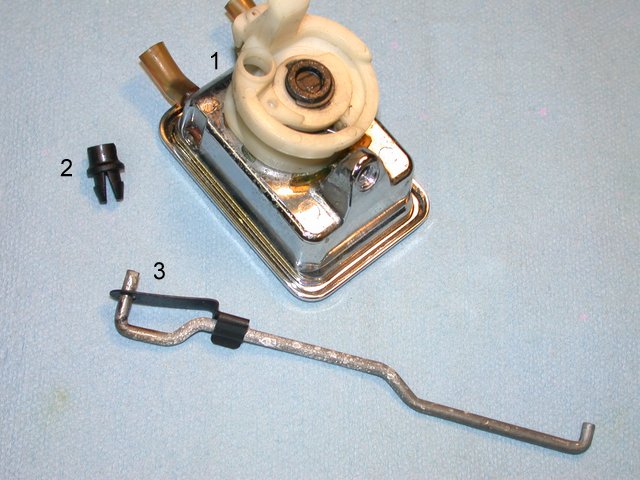|
Hi Art,
You know, I have not seen that type of locking mechanism! Never had a problem with any of the sedans I have. In fact, only a couple passenger doors handles that ever needed adjustment.
In my post I was referring to my 1986 wagon hatch door lock. It definitely does look different.
I must have missed that he had a sedan and not a wagon to make me think again!
The wagon idea stuck harder in my mind for a reason that I complained about the lock intermittently not working, under the Volvo bumper to bumper warranty for 36,000 miles.
That was the beginning of tailgate wiring issues that the dealers didn’t want to tackle, unless it totally quit! Told me to bring it back when it did, totally quit.
That was the third and the last time I ever dealt with any car repair warranty services. In thought now, that was the last time anyone has ever touch any of my vehicles.
I do see a hole in the photo very similar in size of the pin used in the wagon but the orientation is different.
Does the power actuator push or pull a pin out of it to disarm the push button from striking the drum around? No? Yes?
I’m assuming the lock cylinder is in the middle of all of that on the other side? So this one is different.
I was assuming that the principal is the same since a push button in both hatch and trunk have buttons and the power lock actuators were identical.
I see that’s not quite the case!
That assembly looks like it might rotate when pushed and utilizes a cam affair to rotate it maybe?
Just guessing here!
The power actuator system using that hook rod me must rotate the nylon part to rearrange the location of that protruding finger from striking the latch release mechanism.
Until I got my 1992 or 93, I did not know that you could rotate the key to the left to lock out the electric portion from working. I often worried about that, on my 1991, when I left my dogs in the car, with windows down, that a person could access the trunk by pulling the front door knob!
Guess you can say, I don’t experiment much on my cars!
I realize now that the wagon has its lock mechanism mounted to the right of the latch and the key pulls the rod that has the pin. It is the same pin that the power mechanism can also pull and push the pin in the same direction.
You can feel the lock cylinder push and pull the power mechanism with your key.
The pin is inserted into the path of the push button on the wagon through a set of guide holes.
The push button swings the pin held in the two guides. The pin, if it’s retracted in the locked position misses the latch lever.
When the pin is in place to unlock the door, the pin is pushed into the latch mechanism and rotates the lock paws to snap open.
Very similar to our passenger door system that rods pull to release the latch.
On those doors with the pull knob, it pulls a lever on the latch, that allows the door handle movement to pass by the release lever, so the door will not open.
The power actuator is connected to the knob rod and you feel that actuator when you pull the knob up or push it down as well.
I think the lock door knob lever, in the passenger door latches are also designed to block the inside handle from operating the release lever. That is why you have to lift the lock knob before you can get out of the car with the operation of the inside door lever.
As far as what jamming them, this will cause me to have to look into my trunks openings for the button mechanism.
I’ll need to think more and more see for what makes the “cold” stop the button from actuating the latch release. Or it the latch itself?
It all up high in the top of the lip, so unless it’s condensation, it shouldn’t get wet, per say!
I have always said that moisture seeks the coldest parts of the car and the trunk has definitely got those qualifications!
No cabin heat and almost zero air circulation back there at snow driving speeds.
I will have to rely on my imagination to stay away from freezing my own locks in my trunk!
Condensation will have to be my best guess to the problem.
The nylon features gave me the idea of a cam and the rotation of the workings from the photo.
Some moisture barrier type of insulation wrap or possibly lots of silicone spray, around the nylon to metal contact area just might help you this winter.
Maybe a taillight or headlight bulb on, during operation of the car, could drive off just enough moisture to keep it drier in there and help.
You know I have never experienced ice in my door locks! Guess I have really missed that treatment by living in the west and by the ocean coast.
I keep my cars garaged almost continuously to avoid salted moisture and my wheels never get to feel a sandy beach.
When I’m in my southern home and have a third that rotates the other’s back up North for maintenance. That car, which ever I choose is with us and it has to sit outside in the sunshine or rain.
Snow is not allowed fluster up my days, unless, I’m so foolish to drive up to it!
I’m a true blue fair weather driver when possible. I try to miss any and all major rain storms too!
In California, rain storms pass quickly, like a well needed bowel movement. In just a few hours everything slides!
Phil
|

